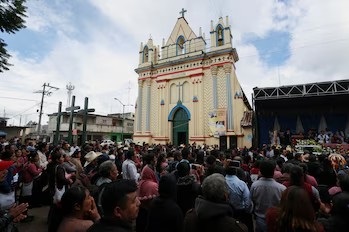The priest was a human rights defender who had been receiving threats for almost a decade.
The city of San Cristóbal de las Casas, located in the municipality of the same name, was included in the Pueblos Mágicos program in 2003 for its attractive colonial buildings, festivals, and crafts. However, such recognition did not prevent organized crime from settling in the region.
On October 20, this emblematic city of Chiapas captured the attention of national and international press. The reason? A pair of armed men murdered the Tsotsil priest and activist Marcelo Pérez Pérez as he left mass.
After the Sunday ceremony at the Cuxtitali parish, Marcelo Pérez got into his truck intending to travel to the Church of Guadalupe. He was executed before starting his journey, and while people around the area were shocked by the attack, his assailants escaped.
Information shared by journalist Héctor de Mauleón indicates that in 2023, San Cristóbal de las Casas was the second tourist city with the highest drug dealing in the country, only behind Cancún, Quintana Roo.
This municipality is located in the Los Altos Tsotsil-Tsetsal region of Chiapas, which also includes areas such as Pantelhó, Amatenango del Valle, Chamula, among others.
In the early 2000s, Los Zetas established themselves in this area to control drug trafficking, illegal logging, fuel theft, and arms and human trafficking.
By 2009, when the Zetas cartel began to decline, the first reports of the appearance of the San Juan Chamula Cartel (CSJC) emerged, an indigenous group that adopted the tactics of Los Zetas and made San Cristóbal de las Casas its main stronghold. It later expanded to regions such as Zinacantán, Oxchuc, Tenejapa, Huixtán, Teopisca, and Chenalhó.
Investigations by Reforma indicate that at that time, when Juan Sabines Guerrero was the governor of Chiapas, the CSJC began to engage in activities such as selling pirated discs, drug dealing, human trafficking, and prostitution of women and minors.
By 2013, reports were already circulating about the presence of gangs known as Los Motonetos, made up of young hooded individuals wearing bulletproof vests, carrying long guns, and communicating via radios.
Over the years, these gangs consolidated as a sort of armed wing of the San Juan Chamula Cartel and took charge of drug, migrant, and arms trafficking, as well as fuel theft. Journalistic reports from El Sol de México specify that in the urban area of San Cristóbal de las Casas, Los Motonetos are mainly engaged in extortion, kidnapping, drug dealing, and armed robbery.
Data shared by journalist Isaín Mandujano with Once Noticias indicates that ‘Los Motonetos’ is not the name of an established organization but is used as a generic term to refer to the multiple hitmen groups operating in the city, characterized by their movement on these two-wheeled vehicles.
“Gunmen and hitmen who rent themselves to the highest bidder have proliferated; they are young people riding motorcycles. Around 10 to 12 gangs move around San Cristóbal de las Casas,” Mandujano explained.
In 2022, Mayor Mariano Alberto Díaz Ochoa acknowledged that the Municipal Police of San Cristóbal de las Casas is overwhelmed, in terms of manpower and weaponry, by organized crime groups, making it incapable of providing security to the population.
Source: Infobae






